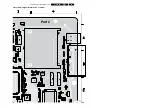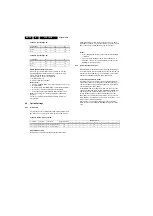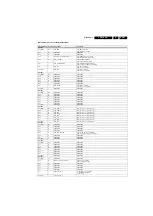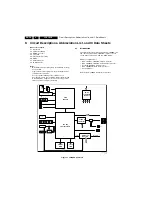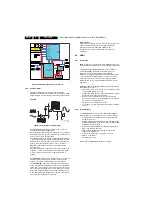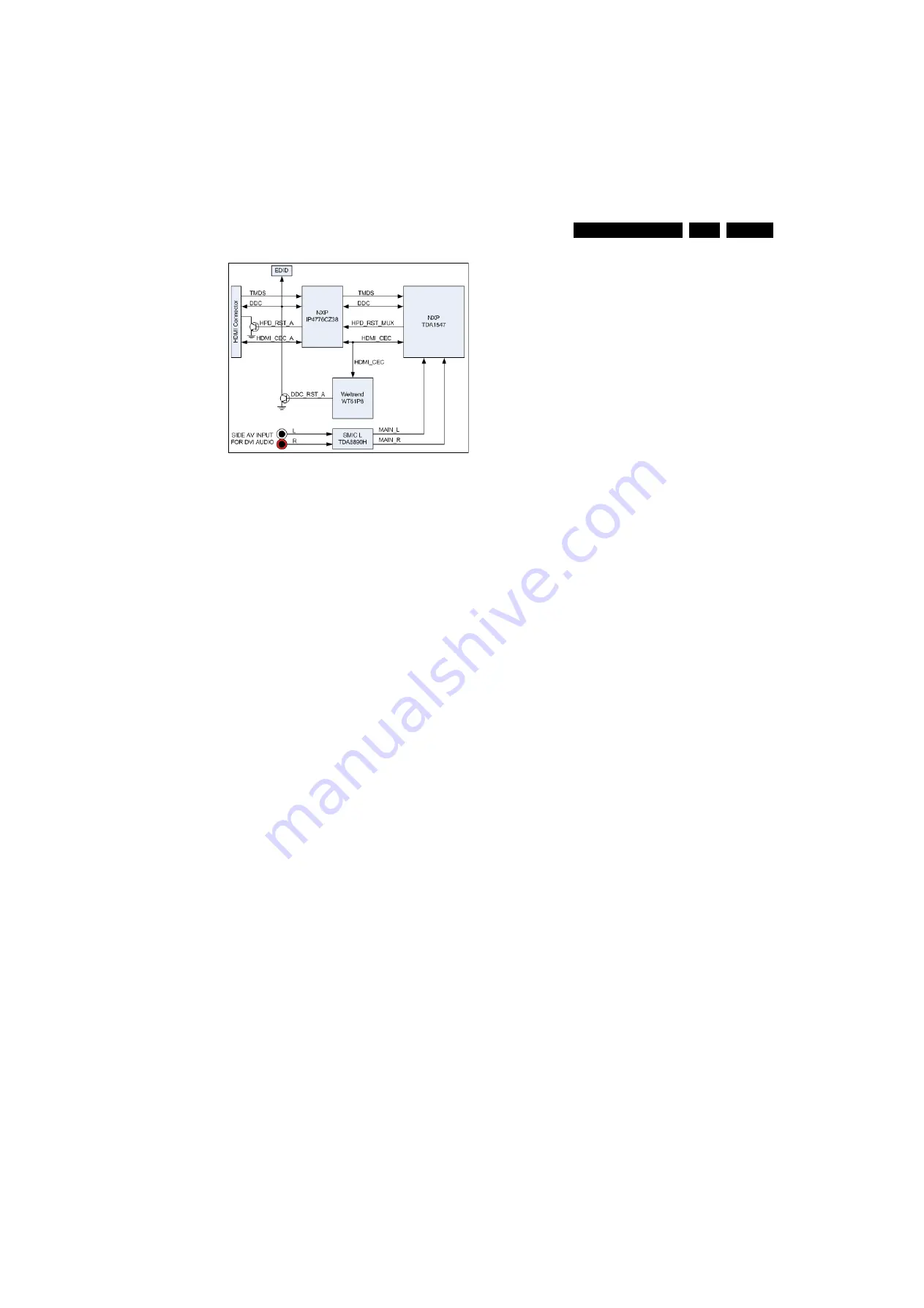
Circuit Descriptions, Abbreviation List, and IC Data Sheets
9.
Figure 9-14 HDMI implementation
The description of the lines is as follows:
•
TMDS (Time Minimized Differential Signal): the actual
HDMI signal
•
DDC (Digital Data Channel): the bus used by the source to
read EDID data in the EEPROM and HDCP
authentification
•
HPD_RST_A (Hotplug Detect Reset signal): used to pull-
down the HPD signal level at the connector when switching
in/out of HDMI mode; the duration of the pulse is around
500-550 ms
•
DDC_RST_A has the same behaviour as the HPD_RST_A
signal. It is used to pull-down the I
2
C clock line to prevent
some problems with certain video graphic cards
•
HDMI_CEC_A is the Consumer Electronic Control remote
control signal bus.
It should be noted that in this chassis the HDCP-key is
embedded in the main processor (no need for a separate
Service-SSB).
9.7
Abbreviation List
1080i
1080 visible lines, interlaced
1080p
1080 visible lines, progressive scan
2CS
2 Carrier Sound
2DNR
Spatial (2D) Noise Reduction
3DNR
Temporal (3D) Noise Reduction
480i
480 visible lines, interlaced
480p
480 visible lines, progressive scan
AARA
Automatic Aspect Ratio Adaptation:
algorithm that adapts aspect ratio to
remove horizontal black bars; keeping
up the original aspect ratio
ACI
Automatic Channel Installation:
algorithm that installs TV channels
directly from a cable network by
means of a predefined TXT page
ADC
analogue to Digital Converter
AFC
Automatic Frequency Control: control
signal used to tune to the correct
frequency
AGC
Automatic Gain Control: algorithm that
controls the video input of the feature
box
AM
Amplitude Modulation
AUO
Acer Unipack Optronics
AP
Asia Pacific
AR
Aspect Ratio: 4 by 3 or 16 by 9
ASD
Automatic Standard Detection
AV
Audio Video
B/G
Monochrome TV system. Sound
carrier distance is 5.5 MHz
BTSC
Broadcast Television System
Committee
CAM
Conditional Access Module
CBA
Circuit Board Assembly (or PWB)
CEC
Consumer Electronics Control bus;
remote control bus on HDMI
connections
CI
Common Interface; E.g PCMCIA slot
for a CAM in a set top box
CL
Constant Level: audio output to
connect with an external amplifier
CLUT
Colour Look Up Table
ComPair
Computer aided rePair
COFDM
Coded Orthogonal Frequency Division
Multiplexing; A multiplexing technique
that distributes the data to be
transmitted over many carriers
CSM
Customer Service Mode
CVBS
Composite Video Blanking and
Synchronisation
CVBS-MON
CVBS monitor signal
CVBS-TER-OUT
CVBS terrestrial out
CVI
Component Video Input
DAC
Digital to analogue Converter
DBE
Dynamic Bass Enhancement: extra
low frequency amplification
DDC
Display Data Channel; is a part of the
"Plug and Play" feature
DFU
Directions For Use: owner's manual
DNR
Dynamic Noise Reduction
DRAM
Dynamic RAM
DSP
Digital Signal Processing
DST
Dealer Service Tool: special
(European) remote control designed
for service technicians
DTS
Digital Theatre Sound
DVB(T)
Digital Video Broadcast; An MPEG2
based standard for transmitting digital
audio and video. T= Terrestrial
DVD
Digital Versatile Disc
DVI
Digital Visual Interface
DW
Double Window
ED
Enhanced Definition: 480p, 576p
EDID
Extended Display Identification Data
(VESA standard)
EEPROM
Electrically Erasable and
Programmable Read Only Memory
EMC
Electro Magnetic Compatibility
EU
EUrope
EXT
EXTernal (source), entering the set by
SCART or by cinches (jacks)
FBL
Fast Blanking: DC signal
accompanying RGB signals
FBL-TXT
Fast Blanking Teletext
FET
Field Effect Transistor
FLASH
FLASH memory
FM
Field Memory / Frequency Modulation
FMR
FM Radio
FRC
Frame Rate Converter
FTV
Flat TeleVision
H
H_sync to the module
HD
High Definition: 720p, 1080i, 1080p
HDCP
High-bandwidth Digital Content
Protection; A "key" encoded into the
HDMI/DVI signal that prevents video
data piracy. If a source is HDCP coded
and connected via HDMI/DVI without
the proper HDCP decoding, the
picture is put into a "snow vision"
mode or changed to a low resolution.
For normal content distribution, the
source and the display device must be
enabled for HDCP "software key"
decoding
I_1
8
170_049.ep
s
3
1070
8

